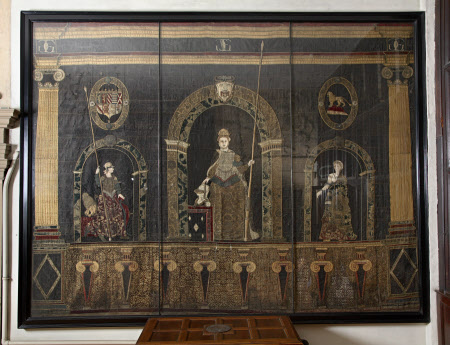Wall hanging: Zenobia flanked by Magnanimitas and Prvdentia
Category
Textiles
Date
c. 1573
Materials
Silk velvet, cloth of gold and silver; linen backing
Measurements
3250 mm (H)4150 mm (W)
Order this imageCollection
Hardwick Hall, Derbyshire
NT 1129593.3
Summary
An embroidered appliqué wall hanging showing the central figure of Zenobia standing in a large portal with personifications of her qualities of Magnanimitas (magnanimity) and Prvdentia (prudence) in smaller portals at each side. They stand within a larger classically inspired setting featuring a foreground of tapering pilasters, a fluted column with an ionic capital at each side and an entablature running along the top. It is one of a set of five hangings commissioned by Elizabeth, Countess of Shrewsbury (1527-1608), to furnish her home at Chatsworth in the 1670s following her fourth marriage to George Talbot, 6th Earl of Shrewsbury (1528-90). They are represented by an intertwined GES for George and Elizabeth Shrewsbury in the centre of the entablature and above each of the flanking columns. Above each of the smaller portals in an oval medallion decorated with two white and two blue heraldic roses and featuring a coronet above a shield bearing the Talbot arms of nine quarterings for George Talbot on the left and the Talbot crest of a lion on a cap of maintenance on the right. The set of five hangings was taken to Hardwick in the late 1580s and 1590s and used to furnish the recently completed New Hall built by the Countess between 1597 and 1601. They are recorded in the Withdrawing Chamber in the 1601 inventory. The hanging is constructed of high value brightly coloured silk fabrics including velvet, satin, tissue and lampas, cloth of silver and gold and is embellished with applied couched decoration of gold and silver filé and silk floss threads, braids and bobbin lace, cords, spangles and purl, all applied to a plain weave linen lining that covers the whole of the reverse.
Full description
This embroidered wall hanging of Zenobia, the warrior queen and ruler the Syrian city of Palmyra, is one of the largest and most splendid embroideries surviving from the Elizabethan age. It is from a set of five showing historical and mythical female figures, which also includes Lucretia, Zenobia, Arthemesia and Cleopatra. They were probably inspired by female characters in Geoffrey Chaucer’s The Legend of Good Women, published in his complete works in 1532 and were intended to show the virtues of their owner, Elizabeth, Countess of Shrewsbury. The group of Noble Women selected by the Countess are all defined by their relationship to their husbands as either wives or widows and in the same way, she constructs her own identity in her textiles though prominent use of the Earl of Shrewsbury’s arms and initials, conjoined with her own. Zenobia was considered to be one of the great queens of antiquity. Chaucer, who calls her Cenobia, describes her as a strong woman whom loved hunting and spoke several languages, while 'To lerne books was al hire liking,/How she in vertu might hir lyf dispend'. She was married to Septimus Adaenathus, ruler of the Syrian city of Palmyra. She continued his military campaigns after his assignation and that of their eldest son in AD266, and having secured Syria and Arabia, installed her younger son as King of Egypt. On the hanging, Zenobia is dressed as a warrior queen, wearing a crown and a breast plate (cuirass) and holding a lance in her left hand whilst resting her right on a helmet (Levy 2007, pp.68-73). Luxurious textiles were a significant part of the furnishing of a sixteenth-century household, used for comfort, decoration and to indicate wealth and the Countess used fine textiles in the form of hangings, table carpets, bed sets and cushions to create a display of opulence and wealth in her homes. This hanging is made using appliqué, a technique where fabric is cut and layered together to create a design, here using the most expensive silk, velvet and cloth of gold, embellished with gold and silver thread. Many of the fabrics came from ecclesiastical vestments removed from churches in the mid-16th century following the changes to religious worship introduced during the English Reformation and, in this case, then recycled as domestic furnishings.
References
Levey, 2007: Santina M. Levey The embroideries at Hardwick Hall: a catalogue. [London]: National Trust, 2007. White 2005: Gillian White, “Pictures of the Vertues”: A Set of Wall-Hangings at Hardwick Hall, Renaissance Journal, vol. 2, no.3, 2005
